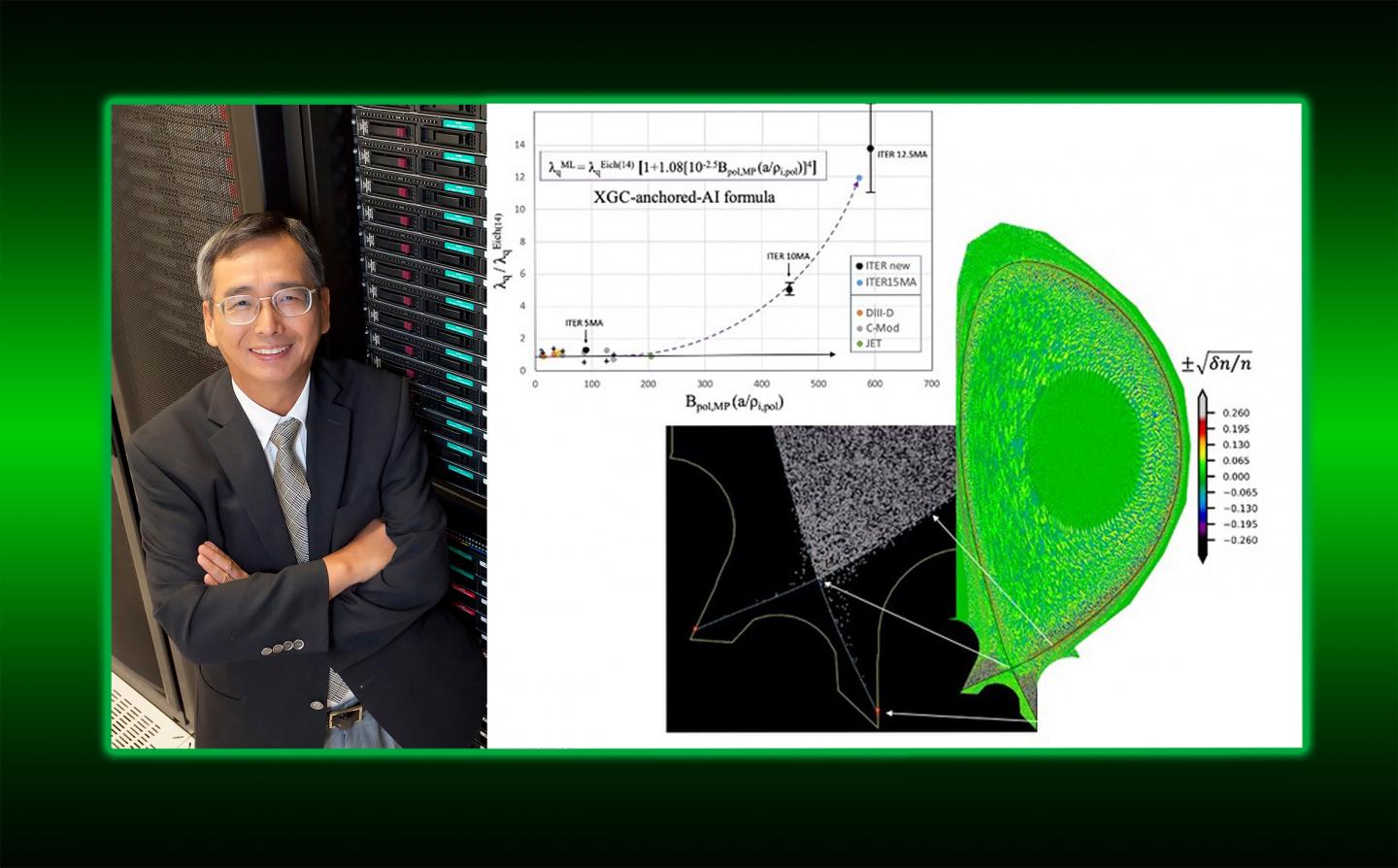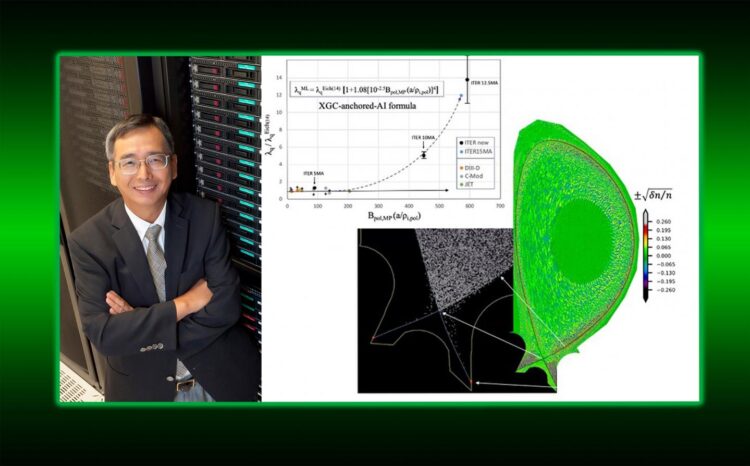
Credit: Photo by Elle Starkman/PPPL Office of Communications. Simulation and image from Robert Hager and Seung-Hoe Ku.
Efforts to duplicate on Earth the fusion reactions that power the sun and stars for unlimited energy must contend with extreme heat-load density that can damage the doughnut-shaped fusion facilities called tokamaks, the most widely used laboratory facilities that house fusion reactions, and shut them down. These loads flow against the walls of what are called divertor plates that extract waste heat from the tokamaks.
Far larger forecast
But using high-performance computers and artificial intelligence (AI), researchers at the U.S. Department of Energy’s (DOE) Princeton Plasma Physics Laboratory (PPPL) have predicted a far larger and less damaging heat-load width for the full-power operation of ITER, the international tokamak under construction in France, than previous estimates have found. The new formula produced a forecast that was over six-times wider than those developed by a simple extrapolation from present tokamaks to the much larger ITER facility whose goal is to demonstrate the feasibility of fusion power.
“If the simple extrapolation to full-power ITER from today’s tokamaks were correct, no known material could withstand the extreme heat load without some difficult preventive measures,” said PPPL physicist C.S. Chang, leader of the team that developed the new, wider forecast and first author of a paper that Physics of Plasmas has published as an Editor’s Pick. “An accurate formula can enable scientists to operate ITER in a more comfortable and cost-effective way toward its goal of producing 10 times more fusion energy than the input energy,” Chang said.
Fusion reactions combine light elements in the form of plasma — the hot, charged state of matter composed of free electrons and atomic nuclei that makes up to 99 percent of the visible universe — to generate massive amounts of energy. Tokamaks, the most widely used fusion facilities, confine the plasma in magnetic fields and heat it to million-degree temperatures to produce fusion reactions. Scientists around the world are seeking to produce and control such reactions to create a safe, clean, and virtually inexhaustible supply of power to generate electricity.
The Chang team’s surprisingly optimistic forecast harkens back to results the researchers produced on the Titan supercomputer at the Oak Ridge Leadership Computing Facility (OLCF) at Oak Ridge National Laboratory in 2017. The team used the PPPL-developed XGC high-fidelity plasma turbulence code to forecast a heat load that was over six-times wider in full-power ITER operation than simple extrapolations from current tokamaks predicted.
Surprise finding
The surprising finding raised eyebrows by sharply contradicting the dangerously narrow heat-load forecasts. What accounted for the difference — might there be some hidden plasma parameter, or condition of plasma behavior, that the previous forecasts had failed to detect?
Those forecasts arose from parameters in the simple extrapolations that regarded plasma as a fluid without considering the important kinetic, or particle motion, effects. By contrast, the XGC code produces kinetic simulations using trillions of particles on extreme-scale computers, and its six-times wider forecast suggested that there might indeed be hidden parameters that the fluid approach did not factor in.
The team performed more refined simulations of the full-power ITER plasma on the Summit supercomputer at the Oak Ridge Leadership Computing Facility (OLCF) at Oak Ridge National Laboratory to ensure that their 2017 findings on Titan were not in error.
The team also performed new XGC simulations on current tokamaks to compare the results to the much wider Summit and Titan findings. One simulation was on one of the highest magnetic-field plasmas on the Joint European Torus (JET) in the United Kingdom, which reaches 73 percent of the full-power ITER magnetic field strength. Another simulation was on one of the highest magnetic-field plasmas on the now decommissioned C-Mod tokamak at the Massachusetts Institute of Technology (MIT), which reaches 100 percent of the full-power ITER magnetic field.
The results in both cases agreed with the narrow heat-load width forecasts from simple extrapolations. These findings strengthened the suspicion that there are indeed hidden parameters.
Supervised machine learning
The team then turned to a type of AI method called supervised machine learning to discover what the unnoticed parameters might be. Using kinetic XGC simulation data from future ITER plasma, the AI code identified the hidden parameter as related to the orbiting of plasma particles around the tokamak’s magnetic field lines, an orbiting called gyromotion.
The AI program suggested a new formula that forecasts a far wider and less dangerous heat-load width for full-power ITER than the previous XGC formula derived from experimental results in present tokamaks predicted. Furthermore, the AI-produced formula recovers the previous narrow findings of the formula built for the tokamak experiments.
“This exercise exemplifies the necessity for high-performance computing, by not only producing high-fidelity understanding and prediction but also improving the analytic formula to be more accurate and predictive.” Chang said. “It is found that the full-power ITER edge plasma is subject to a different type of turbulence than the edge in present tokamaks due to the large size of the ITER edge plasma compared to the gyromotion radius of particles.”
Researchers then verified the AI-produced formula by performing three more simulations of future ITER plasmas on the supercomputers Summit at OLCF and Theta at the Argonne Leadership Computing Facility (ALCF) at Argonne National Laboratory. “If this formula is validated experimentally,” Chang said, “this will be huge for the fusion community and for ensuring that ITER’s divertor can accommodate the heat exhaust from the plasma without too much complication.”
The team would next like to see experiments on current tokamaks that could be designed to test the AI-produced extrapolation formula. If it is validated, Chang said, “the formula can be used for easier operation of ITER and for the design of more economical fusion reactors.”
###
Conducting this research and co-authoring the paper were U.S. and international researchers. Members of the team included PPPL physicists Seung-Hoe Ku, Robert Hager and Michael Churchill, with Jerry Hughes of the Plasma Science and Fusion Center at MIT; Florian Köchl of the Vienna University of Technology; Alberto Loarte and Richard Pitts of ITER; and Vassili Parail of the Culham Centre for Fusion Energy in the United Kingdom.
Support for this work comes from the DOE Office of Science through the Scientific Discovery through Advanced Computing (SciDAC) program. DOE’s Novel Computational Impact on Theory and Experiment (INCITE) program provided the OLCF and ALCF computing resources. OLCF and ALCF are DOE Office of Science user facilities.
PPPL, on Princeton University’s Forrestal Campus in Plainsboro, N.J., is devoted to creating new knowledge about the physics of plasmas — ultra-hot, charged gases — and to developing practical solutions for the creation of fusion energy. The Laboratory is managed by the University for the U.S. Department of Energy’s Office of Science, which is the single largest supporter of basic research in the physical sciences in the United States and is working to address some of the most pressing challenges of our time. For more information, visit energy.gov/science.
Media Contact
John Greenwald
[email protected]
Original Source
https:/
Related Journal Article
http://dx.





